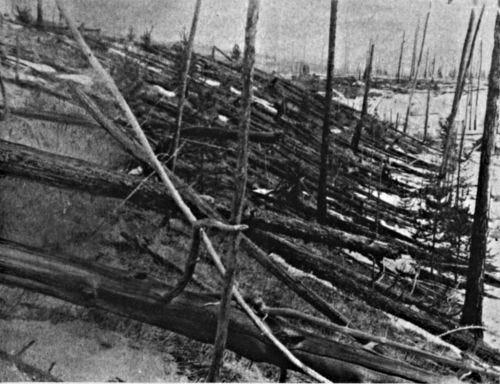The Enigma of the Tunguska Event: A Historical Perspective
Written on
Chapter 1: The Tunguska Explosion
On June 30, 1908, shortly after 7 AM, a colossal explosion occurred near the Stony Tunguska River in Central Russia, marking the largest recorded impact event in history. This incident, known as the Tunguska Event, remains shrouded in mystery.
The prevailing hypothesis suggests that a meteor triggered this explosion, yet no impact crater has ever been discovered. It is believed that the meteor detonated at an altitude of three to six miles (4.8 to 9.6 km). Despite the absence of a crater, the destruction was staggering—approximately 800 square miles (1,287 sq km) of forest were devastated, encompassing around 80 million trees. The force of the explosion was so immense that the trees were knocked down in a radial fashion, with their bark and branches stripped away.
A team did not set out to investigate the site until 1921, but the severe Siberian climate hindered their efforts to reach ground zero. It was not until 1927, nearly two decades later, that an expedition finally arrived at the blast site. They uncovered something astonishing: while trees surrounding the epicenter were flattened, those right at the center remained standing. Remarkably, there was no indication of fatalities resulting from the explosion.

Chapter 1.1: The Meteor Hypothesis
The most accepted explanation for the Tunguska Event is that a meteor, roughly 120 feet (37 meters) in diameter, entered the Earth’s atmosphere at a staggering speed of 33,500 miles per hour (53,913 km/h). This entry generated extreme heat, raising the air temperature to around 44,500 degrees Fahrenheit (24,704 degrees Celsius). Due to the immense pressure and heat, it is believed that the meteor disintegrated and exploded at an altitude of about 28,000 feet (8,534 meters).
Estimates suggest that the explosion released energy equivalent to 3 to 5 megatons of TNT, comparable to the power of 185 Hiroshima atomic bombs. The resulting shockwave would have registered approximately 5.0 on the Richter scale. Meteorological stations across Europe even detected seismic and atmospheric waves emanating from the explosion. Strikingly, natural phenomena were reported thousands of miles away; the night sky in Europe and Asia glowed for several nights after, with clouds shimmering and the sky taking on a yellow hue.
The first video titled "Breaking Down The Mysterious Tunguska Explosion • Mystery Files Debrief" offers a detailed analysis of this peculiar event, delving into the scientific theories and historical context surrounding the explosion.
Chapter 1.2: The Crater Conundrum
The absence of a crater at the explosion site has led to various alternative theories. One theory posits that a space rock exploded mid-air, supported by the discovery of small pits interpreted as minor craters created by fragments of the meteorite. Another hypothesis suggests that a comet impacted the area; since comets are largely composed of ice, it would have vaporized upon entry, leaving no physical evidence.
Other intriguing theories have emerged regarding the lack of debris and craters. Some propose that it was a nuclear explosion caused by extraterrestrial forces, while others speculate about a small black hole colliding with Earth or an underground eruption releasing hot gases that resulted in an atmospheric explosion.
Despite the multitude of theories, no conclusive evidence has emerged to definitively explain the explosion. As it stands, the theory of a meteorite exploding in mid-air remains the most widely accepted, and the Tunguska Event continues to captivate the imagination as an unsolved mystery.
The second video, "Tunguska Event | 100 Wonders | Atlas Obscura," provides additional insights into the event and its implications, making it a valuable resource for those seeking to understand this fascinating historical occurrence.
Chapter 2: Continuing Mysteries
As research into the Tunguska Event persists, the enigma surrounding it only deepens, inviting further exploration and speculation. For those interested in uncovering more intriguing facts, consider exploring "The Wonderful World of Completely Random Facts" series on Medium, or delve into the four volumes of "Knowledge Stew: The Guide to the Most Interesting Facts in the World" for even more captivating stories.